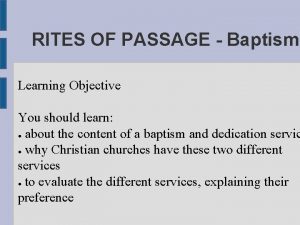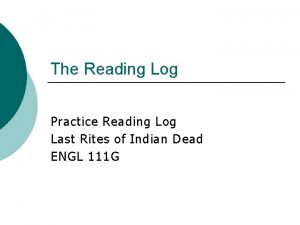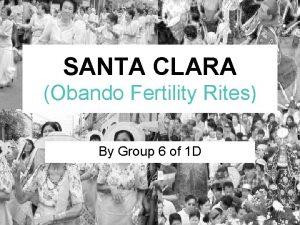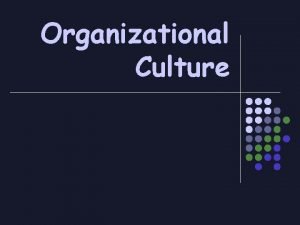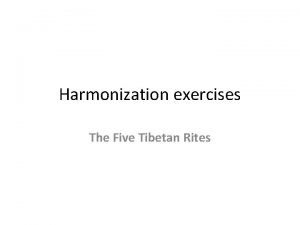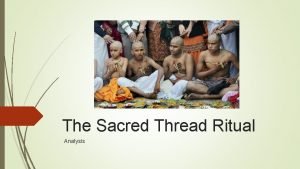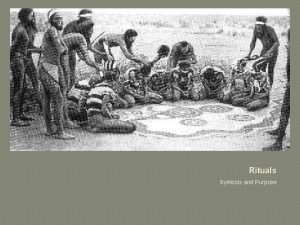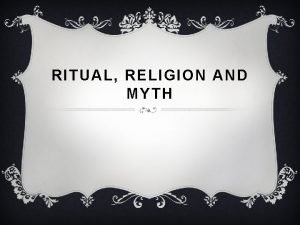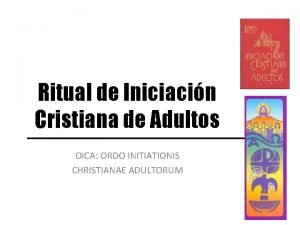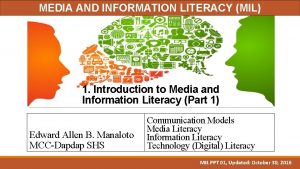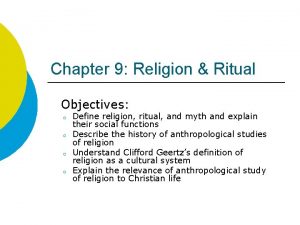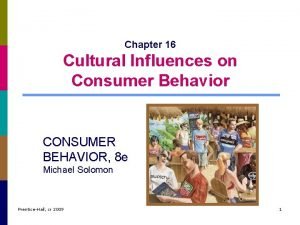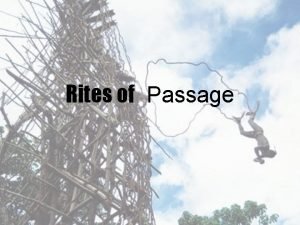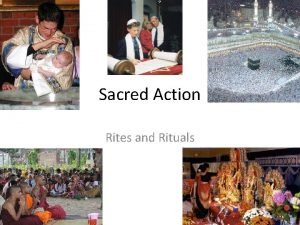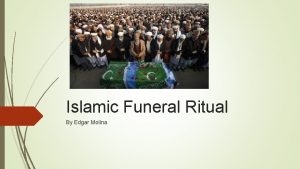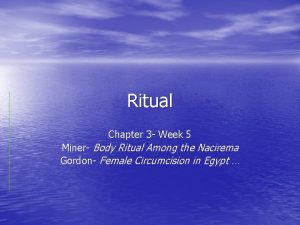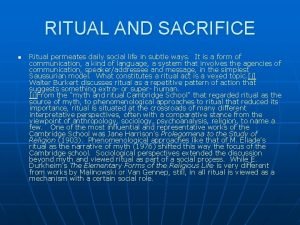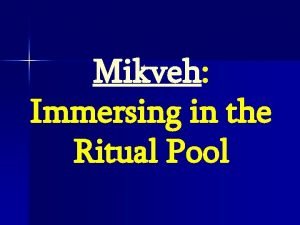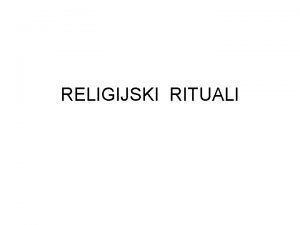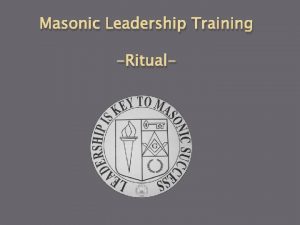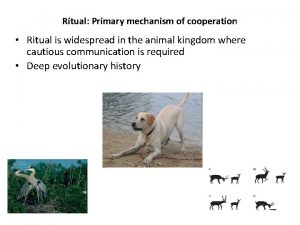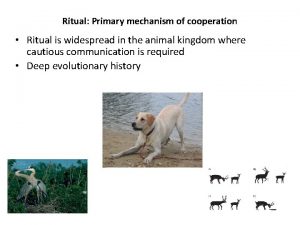RITUAL THEORY RITES OF PASSAGE 9 22 16
















- Slides: 16

RITUAL THEORY & RITES OF PASSAGE 9. 22. 16

CREATION UNIT REVIEW • RELIGIOUS TEXTS (PRIMARY SOURCES) • Genesis 1 -3 • Enuma Elish • Gospel of Mary; Gospel of Thomas • Qur’an Sura 7

CREATION UNIT REVIEW • THEORISTS (SECONDARY SOURCES) • Eliade • • Lincoln • • Minimalist vs maximalists, polythetic definition of religion Ruether • • Hierophany, sacred space vs profane space, axis mundi, religious man vs modern man religious texts reveal values of society Pagels • censored texts reveal values of society

FUNCTIONS OF RITUAL • Orients participants to space and time • Connects participants to the divine • Connects participants to a larger community • Includes the body as an instrument for religion O Brother Where Ar’t Thou Delmar’s Baptism What about Grimes’ “Afro-Caribbean-Polish ‘baptism’”?

KINDS OF RITUALS • Calendar Rituals • Life Cycle Rituals • Daily • Birth • Weekly • Coming of age • Monthly • Marriage • Yearly • Death • Special Occasion Rituals • Ordination • Exorcism Eucharist

ARNOLD VAN GENNEP (1873 -1957) • Rites of passage • • “rites which accompany every change of place, state, social position and age” Three stages of initiation rites (rites of passage) • Separation - the initiate is removed from the rest of the community • Transition (or limen / “threshold”) - the initiate leaves the community until the rites are complete • Re-Aggregation - the initiate rejoins the community

VICTOR TURNER (1920 - 1983) • Expands upon van Gennep’s theory, specifically focusing on liminality • • Focused on the “potential” available in liminal state; especially in relation to deconstructing social systems • • also related to Eliade and phenomenology where cultural and ritual creativity are incubated Genuine ritual is transformative; ceremony confirms the status quo

LIMINALITY AND COMMUNITAS • Liminality • Betwixt and Between • No clear social status • unclear status makes liminality dangerous to community and social system Hazing of fraternity pledges as depicted on Law & Order SVU • Why?

LIMINALITY AND COMMUNITAS • Communitas • group of people who are in the same liminal state • “common generic bond” • (Majority) Anti-structure • Social distinctions fall away Selma to Montgomery March, 1965

SIGNIFICANCE OF RITES OF PASSAGE • “Social life is a dialectical process that involved successive experience of high and low” • All cultures have successive moments of highs/lows marked by ritual • Rituals help in process that humans go through anyway

HOPI KACHINA CULT • Hopi — Native American Pueblo Tribe • Kachina • Supernatural Beings - represent aspects of natural world, not gods • Kachina Dancers • Kachina Dolls given to children • Kiva - subterranean ritual / ceremony space • Central theme of Kachina cult: “The presence of life in all objects that fill the universe. Everything has an essence or a life force, and humans must interact with these or fail to survive”

HOPI INITIATION RITUAL • What: Initiation into Kachina cult • Purpose: Reveal to children nature of the kachinas • Who: 8 -10 year olds • What happens: • Children are removed from community • Whipped by Kachinas - “payment” to receive special knowledge; device to ensure secrecy • Kachinas unmasked - members community, possibly relatives • Profound disappointment, disenchantment, discord

DISENCHANTMENT • Dual traumatic effects: • • disenchantment • altered concepts of Kachinas • profound disappointment and resentment towards elders modified behavior • excessive indulgence by their elders end • irreversible loss of naive realism

WHAT’S NEXT? • • Active members of the Kachina cult • attentive to Kachina stories • participating in religious preparation and activities Birth of religious perspective • Religious life begins as serious and reflective (adult qualities) • Motivation for seeking religious awareness

CHARACTERISTICS OF DISENCHANTMENT (PG 236) • Encouraging identification of the spiritual with some physical / sensual aspect of the world • Initiatory process • • • reinforces sense that the fullness of religious reality is invested in these figures and objects Concluding moments / / Threshold • Illusion dissolved • “Rites demonstrate irreversibly that things are not simply what they appear to be, that onedimensional literalism is a childish faith that one has to grow beyond” Choice: • See the world as meaningless • Quest for fuller understanding of the world

EXAMPLES OF DISENCHANTMENT • Similarities to first members of Christian community? • Disenchantment in secular modernity?
 Christian rites of passage baptism
Christian rites of passage baptism Catholic terminology
Catholic terminology Last rites for indian dead
Last rites for indian dead Obando fertility rites festival
Obando fertility rites festival Policyrules
Policyrules Holy orders form
Holy orders form What is the eucharistic prayer
What is the eucharistic prayer 6 tibetan rites
6 tibetan rites Ritual analysis
Ritual analysis Symbols and rituals
Symbols and rituals V
V Ritual of the secular franciscan order
Ritual of the secular franciscan order Ordo initiationis christianae adultorum
Ordo initiationis christianae adultorum Formative assessment analyze and explain this illustration
Formative assessment analyze and explain this illustration Ritual kinship meaning
Ritual kinship meaning Ritual definition sociology
Ritual definition sociology Grooming ritual meaning
Grooming ritual meaning
